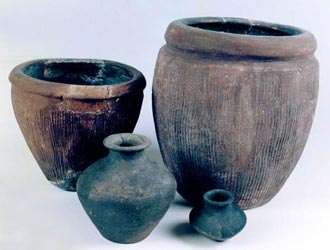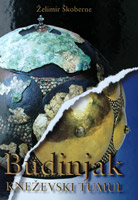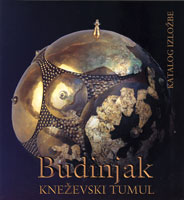Collection The Prehistoric Archaeology Collection
Although in 2007 Zagreb City Museum celebrated the centennial of its work, the archaeological collection is of a more recent date and was founded in 1993, when the museum for the first time employed an archaeologist. Because of the major archaeological investigations (1989-1995) during the reconstruction of the main building of the museum (previously the convent of the Order of Poor Clares) and the production of the new permanent display, as well as because of the ever-increasing needs for archaeological investigations in the old city centre, in 1997 the museum created a position for a second archaeologist. This created the premises for the division of the collection into a prehistoric and a medieval collection, within which it was possible to classify almost all of the archaeological holdings of the museum.
Because of the vigorous programme of excavations that the museum conducts in the city and surrounds, and the large quantity of newly found material, the founding of a new collection (for example, numismatic or modern) is actively under consideration.
The prehistoric collection of Zagreb City Museum contains finds that were acquired by gifts, reconnoitring and excavations. Most of the finds were acquired in the last score of years, when the research was stepped up. Prehistoric finds that are kept in the ZCM and were found by expertly run excavations can be considered in three groups.
 The first group consists of finds collected during investigation of the site of the Zagreb City Museum itself, i.e. the Poor Clares’ Convent.
The first group consists of finds collected during investigation of the site of the Zagreb City Museum itself, i.e. the Poor Clares’ Convent.
Although it had earlier been thought, and indeed, finds in the suburb had indicated, that in prehistory Gradec was an important settlement, these finds for the first time gave a glimpse of the size and importance of Zagreb’s Gradec in the first millennium BC.
The abundance of finds and the quality of workmanship of Late Bronze Age and Iron Age potters and founders show the high quality of life on Gradec hill.
The second group is constituted by finds collected in rescue excavations at various locations, particularly in the Upper Town of Zagreb (St Mark’s Square, Grič, Demetrova 7 and so on), which just filled in our knowledge of prehistoric Gradec, both culturally and temporally. It was established that the Gradec plateau was inhabited in its entirety from the end of the second millennium BC. Undoubtedly, this Gradec was then a large regional centre, which played an important and very likely a dominant role in the formation of the cultural identity of the whole area.
The third group consists of finds excavated at the site called Budinjak in Žumberak, where ZCM has systematically been conducting research since 1993. Budinjak is located in the central part of the Žumberak Hills at a height above sea level of 740 m, some fifty kilometres west of Zagreb. This was a fortified settlement (the hill fort called Židovske kuće) and a tumulus necropolis from the time of the Old Iron Age (Hallstat culture). Broader excavations of this site should explain the manners of interment and give new finds and understandings about Halstatt culture in north west Croatia.


The wealth of finds discovered to date at the necropolis in Budinjak tells of the economic strength of the Old Iron Age population that dwelled in the hill fort at Budinjak. This economic strength is comparable with that of the richest Iron Age finds from the south east Alps. The importance and significance of the finds tell of the importance of investigation of this site for the study of central European prehistory (Halstatt culture).
Želimir Škoberne, museum adviser
Related exhibitions
Zagreb before Zagreb, Zagreb City Museum, 1994
Budinjak – a Princely Tumulus, Zagreb City Museum, 1999
Žumberak: 20 Years on... (Gornja Vas 1982 - Budinjak 2001), Samobor Museum, 2001
Žumberak: 20 Years on... (Gornja Vas 1982 - Budinjak 2001), Budinjak, 2001
Budinjak and Libna, Krško (Slovenia), 2001
Helmets in Croatia, Zvonimir Gallery, Zagreb, 2001
Revived Cultures - Archaeological Excavations in the Gorjanci/Žumberak Hills, Ljubljana, 2002
Žumberak – from Prehistory to Late Antiquity, Archaeological Museum, Zagreb, 2002
The Iron Age and the Roman Period on Žumberak / Gornja Vas, 1982 – Budinjak 2002, Local Heritage Museum, Ozalj, 2003
Warriors at the Crossroads of East and West the Early Iron Age in Continental Croatia, Archaeological Museum, Zagreb, 2004
A Brook in the Heart of Zagreb - Along the Medveščak Brook from source to mouth, Zagreb City Museum, 2005
Warriors at the Crossroads of East and West the Early Iron Age in Continental Croatia, Museum of Slavonia, Osijek, 2005
Warriors at the Crossroads of East and West the Early Iron Age in Continental Croatia, Varaždin Municipal Museum, 2006
In the Service of Archaeology, Zagreb City Museum, 2013
Budinjak – the field of tumuli: archaeological investigations 1995 – 2014, Zagreb City Museum, 2016
Von Budinjak nach Mainz – From Budinjak to Mainz, Mainz City Hall’s Gallery, 2017
Related publications
.jpg) Škoberne, Želimir. Overview of Research. // Zagreb before Zagreb : The archaeological heritage of Zagreb from prehistory to the foundation of the Bishopric in 1094 / editor Ante Rendić-Miočević.
Škoberne, Želimir. Overview of Research. // Zagreb before Zagreb : The archaeological heritage of Zagreb from prehistory to the foundation of the Bishopric in 1094 / editor Ante Rendić-Miočević.
Zagreb : Archaeological Museum Zagreb ; Zagreb City Museum ; Sesvete : Prigorje Museum ; Velika Gorica : Turopolje Museum, 1994, pp. 57-59.
Škoberne, Želimir. The Iron Age. // Zagreb before Zagreb : The archaeological heritage of Zagreb from prehistory to the foundation of the Bishopric in 1094 / editor Ante Rendić-Miočević.
Zagreb : Archaeological Museum Zagreb ; Zagreb City Museum ; Sesvete : Prigorje Museum ; Velika Gorica : Turopolje Museum, 1994, pp. 66-68.
 Škoberne, Želimir. Budinjak : a Princely Tumulus.
Škoberne, Želimir. Budinjak : a Princely Tumulus.
Zagreb : Zagreb City Museum, 1999
 Škoberne, Želimir. Budinjak : a Princely Tumulus : Exhibition Catalogue.
Škoberne, Želimir. Budinjak : a Princely Tumulus : Exhibition Catalogue.
Zagreb : Zagreb City Museum, 1999
 Škoberne, želimir. A Review of Prehistoric Archaeological Research at Žumberak. // Žumberak from Prehistory to the Roman Period / editor Vesna Herak.
Škoberne, želimir. A Review of Prehistoric Archaeological Research at Žumberak. // Žumberak from Prehistory to the Roman Period / editor Vesna Herak.
Zagreb : Archaeological Museum, 2002, pp. 32-82.
 Križ, Borut; Želimir Škoberne. A Review of Prehistoric Archaeological Research at Žumberak-Gorjanci. // Revived Cultures : Archaeological Excavations in the Gorjanci/Žumberak Hills / editors Nina Pirnat-Spahič and Želimir Škoberne.
Križ, Borut; Želimir Škoberne. A Review of Prehistoric Archaeological Research at Žumberak-Gorjanci. // Revived Cultures : Archaeological Excavations in the Gorjanci/Žumberak Hills / editors Nina Pirnat-Spahič and Želimir Škoberne.
Ljubljana : Cankarjev Dom Cultural and Congress Center, 2002, pp. 34-73.
 Bugar, Aleksandra; Boris Mašić. In the service of archaeology.
Bugar, Aleksandra; Boris Mašić. In the service of archaeology.
Zagreb : Zagreb City Museum, 2013
Related papers
Ankner, Dietrich. Die Bronze des Schüsselhelmes von Budinjak. // Jahrbuch des Römisch-Germanischen Zentralmuseums Mainz : 45. Jahrgang 1998 : Teil 2. Mainz : Römisch-Germanisches Zentralmuseum, 1999, pp. 469-472.
Škoberne, Želimir. A Find of Unusual Multi-headed Pin from the Necropolis of Budinjak. // Opuscula Archaeologica, 27(2003), pp. 199-210.
Škoberne, Želimir. Archaeological Excavations on the Prehistoric Necropolis Budinjak on the Mount Žumberak. // Hrvatski arheološki godišnjak (Croatian Archeological Yearbook), 1(2004). Zagreb : Ministry of Culture, pp. 105-107.
Škoberne, Želimir. Archaeological Excavations on the Prehistoric Necropolis Budinjak on the Mount Žumberak. // Hrvatski arheološki godišnjak (Croatian Archaeological Yearbook), 2(2005). Zagreb : Ministry of Culture, pp. 147-149.
Škoberne, Želimir. Archaeological Excavations on the Prehistoric Necropolis Budinjak on the Mount Žumberak. // Hrvatski arheološki godišnjak (Croatian Archaeological Yearbook), 3(2006). Zagreb : Ministry of Culture, pp. 172-174.
Škoberne, Želimir. Archaeological Excavations on the Prehistoric Necropolis Budinjak on the Mount Žumberak. // Hrvatski arheološki godišnjak (Croatian Archaeological Yearbook), 4(2007). Zagreb : Ministry of Culture, pp. 187-189.
Škoberne, Želimir. Archaeological Excavations on the Prehistoric Necropolis Budinjak on the Mount Žumberak. // Hrvatski arheološki godišnjak (Croatian Archaeological Yearbook), 5(2008). Zagreb : Ministry of Culture, 2009, pp. 247-250.
Related reviews
Glogović, Dunja. Book Reviews : Želimir Škoberne: Budinjak : Princely Tumulus. // Arheološki vestnik, 52(2001), pp. 402-403.

